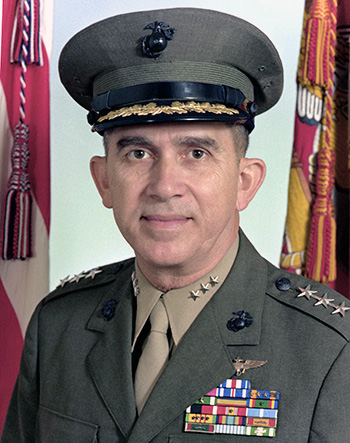
|
William H. Fitch |
 |
|||
| Rank, Service | ||||
Lieutenant General O-9, U.S. Marine Corps |
||||
| Veteran of: | ||||
|
||||
| Tribute: | ||||
Bill Fitch was born on November 6, 1929, in Chattanooga, Tennessee. After graduating from the University of Florida with a bachelor's degree in June 1950, he entered the Naval Aviation Cadet Program on September 2, 1950, and was commissioned a 2d Lt in the U.S. Marine Corps and designated a Naval Aviator on April 1, 1952. Lt Fitch then completed advanced training at NAS Corpus Christi, Texas, from April to June 1952, followed by service as an F4U-5N Corsair pilot with VMF-114 at MCAS Cherry Point, North Carolina, from July 1952 to July 1953. His next assignment was as an AD-4B Skyraider pilot with VMA-324 at MCAS Miami, Florida, from July 1953 to November 1954, and during this time he flew missions in support of the Korean War armistice and ferried aircraft to the French in Vietnam during the 1st Indo-China War. After completing jet upgrade training, Photo Reconnaissance School, and F9F-5 Panther training, Lt Fitch served as an F9F-5P pilot with VMJ-3 and VMCJ-3 at MCAS Miami and then MCAS El Toro, California, from June 1955 to April 1956, followed by service on the staff of the 3rd Marine Aircraft Wing at MCAS El Toro from April 1956 to July 1957. Capt Fitch next completed Test Pilot School at NAS Patuxent River, Maryland, in February 1958, and then served as a flight test project officer with VX-5 at MB China Lake, California, from April 1958 to May 1960. During this time he invented and flight tested the multiple carriage bomb rack, which evolved into the multiple ejector and triple ejector racks used on most jet attack and fighter aircraft today. His next assignment was as an A-4B Skyhawk pilot with VMA-311 at Yokusuka, Japan, from May 1960 to March 1962, and then as a staff officer in the Bureau of Weapons and with the Research and Development Division in the Office of the Chief of Naval Operations at the Pentagon from May 1962 to July 1965. Maj Fitch served at MCS Quantico, Virginia, from August 1965 to June 1966, and then with H&MS-14 at MCAS Cherry Point, North Carolina, from June to October 1966. His next assignment was as an A-6 Intruder pilot and Commanding Officer of VMA(AW)-225 at MCAS Cherry Point from October 1966 to June 1967, and then as Commanding Officer of VMA(AW)-533 at Chu Lai, South Vietnam, from July 1967 to September 1968. Col Fitch was next assigned to Headquarters U.S. Marine Corps at the Pentagon from September 1968 to August 1970, followed by National War College from August 1970 to August 1971. He then served with H&MS-32 at MCAS Beaufort, South Carolina, from August to September 1971, and MWHS-2 at MCAS Cherry Point from September 1971 to April 1972. His next assignment was as Commanding Officer of Marine Aircraft Group 14 at MCAS Cherry Point from April 1972 to September 1973, followed by service as Commanding Officer of the 32nd Marine Expeditionary Unit with Fleet Marine Force Atlantic in the Mediterranean Sea from September 1973 to July 1974. Col Fitch served as G-3 on the staff of the 2nd Marine Aircraft Wing at MCAS Cherry Point from July 1974 to July 1975, and then served as Executive Assistant to LtGen Tom Miller at Headquarters U.S. Marine Corps in the Pentagon from August 1975 to April 1976. Gen Fitch served as Assistant Commander of the 1st Marine Aircraft Wing on Okinawa from May to December 1976, followed by service as Commanding General of the 9th Marine Amphibious Brigade in South Korea from December 1976 to May 1977. His next assignment was as Deputy Chief of Staff for Research, Development, and Studies at Headquarters U.S. Marine Corps in the Pentagon from May 1977 to June 1980, and then as Commanding General of the 1st Marine Aircraft Wing on Okinawa from June 1980 to June 1982. His final assignment was as Deputy Chief of Staff for Aviation with Headquarters U.S. Marine Corps from June 1982 until his retirement from the Marine Corps on September 1, 1984. |
||||
|
||||

